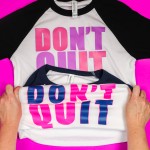How to Use Stretch HTV
Have you ever tried putting regular HTV on stretch fabric? When the fabric stretches the HTV puckers and looks terrible.Using stretch HTV will fix all of those issues. You're going to love how much better stretch HTV works on stretchy fabric than regular HTV.
Equipment
- Cricut EasyPress
- Teflon Sheet
- StandardGrip Mat
- StrongGrip Mat
What You Will Need
- Free "Don't Quit" file
- BELLA+CANVAS Baby Tees
- Siser EasyWeed Stretch
- Cricut SportFlex
- Hotmark Revolution
Instructions
How to Use Stretch HTV on Stretchy Fabric
- To begin, add your material to the mat shiny side down. All of these materials are kind of shiny on both sides. If you're not sure which side is the carrier sheet you can check by lifting one corner.
- With these materials I have found that they don't like to stick to lighter grip mats. I recommend using a StandardGrip mat or StrongGrip mat. I also recommend using your brayer to make sure the material is stuck down really well onto the mat.
Cutting Stretch HTV with a Cricut Machine
- Make sure the fine-point blade is installed and then load the mat into the machine and press Go.
- I cut all of these materials on the same SportFlex setting and it worked great for all three materials.
- Once the design is done cutting unload the mat and it's time to weed all of the excess.
Weeding Stretch HTV
- To weed the materials I am using my weeding tool. We need to weed out all of the excess material, which means everything we don't want to be pressed onto the fabric.
How to Apply Stretch HTV to Stretchy Fabrics
- For my projects today I am using my large EasyPress. When it comes to applying heat you want to follow the time, temperature, and pressure settings for your HTV material.
- With each fabric, you will need to pre-press the area you're applying the HTV to. This will remove any wrinkles and any moisture that is in the fabric.
- After pre-pressing I like to go over the area with a lint roller to make sure there is no hair, dust, lint, etc on the fabric. Having things between the fabric and the adhesive can create a less-than-desirable finished product.
- When your shirt is prepped locate the bottom layer of HTV onto the fabric.
- Cricut SportFlex Iron-on has a time and temp setting of 305° for 30 seconds. It also calls for firm pressure. You'll need to apply firm pressure the entire time.
- I added an EasyPress mat inside my shirt and then pressed the first layer for about half the time.
- SportFlex is a cool peel product. You need to allow the carrier sheet to cool completely before trying to remove it.
- You'll want to start at the corner and peel it back slowly making sure the HTV is stuck down on the shirt.
- If you notice any lifting, lay the carrier sheet back down and press again. Allow to cool and remove the carrier sheet.
- Save your carrier sheet, we'll need it when applying the top layer.
How to Layer Stretch HTV
- To layer the Stretch HTV we'll lay the 2nd layer on top of the first layer. Your design should align right over the bottom layer.
- I find it can be easier to get the layers to line up if you separate it into smaller pieces.
- You need to make sure the entire design is covered with a carrier sheet. You don't want the heat source to touch the HTV directly.
- This time we will press the HTV for the full time, full pressure.
- Again, this is a cool peel material. Allow the HTV to cool completely and peel back the carrier sheet. Go slowly and make sure the HTV is stuck down everywhere.
- If you have any lifting, lay the carrier sheet back down and press again with firm pressure for a few seconds.
How to Remove Press Marks
- Remove all of the carrier sheets and then lay a teflon sheet over the top of the whole design.
- Press the whole design for about 10 seconds and then peel back the teflon sheet. If you still see lines you can repeat this process again if needed.
- If you have any lifting of HTV you could follow these same steps to press them back down. Make sure anywhere you are applying heat is covered with a carrier sheet or teflon sheet.
